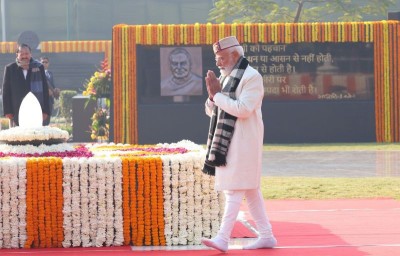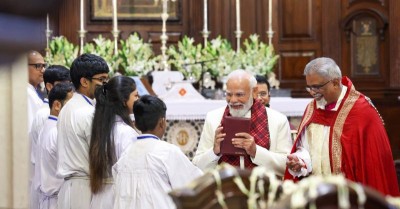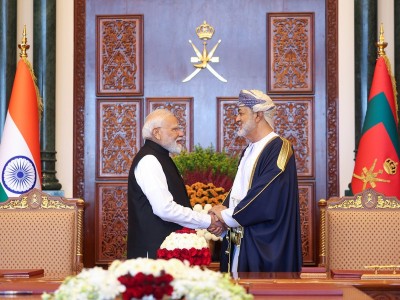
Nagaland: Democratic Consolidation
Nagaland Governor P.B. Acharya on March 6, 2018, stated that the Naga ‘political issue’ would be resolved within six months. He further asserted that if Nagaland and the Northeast were to progress, then the Naga issue should be brought to a conclusion and the welfare of the Nagas should be on the agenda.
On March 3, 2018, the Election Commission of India (ECI) declared the results of the Nagaland Assembly Elections held on February 27, 2018. The Naga People’s Front (NPF), leading constituent of the erstwhile ruling coalition, the Democratic Association of Nagaland (DAN), emerged as the leading party with 26 seats, followed by the newly formed National Democratic People's Party (NDPP), with 18 seats; Bharatiya Janata Party (BJP), 12 seats; National People’s Party (NPP), two seats; Janata Dal-United (JD-U), one seat; and one seat to an independent candidate. The State Assembly has 60 seats. Former Chief Minister Neiphiu Rio of National Democratic Progressive Party was declared winner from the Northern Angami-II Assembly seat, uncontested.
Governor P.B. Acharya swore-in the Neiphiu Rio-led Progressive Democratic Alliance (PDA) Government on March 8, 2018, at Khuochiezie in Kohima District. The PDA alliance has the support of 32 Members of the Legislative Assembly (MLAs): National Democratic People's Party (NDPP), 18 MLAs; Bharatiya Janata Party (BJP), 12 MLAs; Janata Dal-United (JD-U), one MLA and one independent MLA, Tongpang Ozukum. The State unit of the National People’s Party (NPP) withdrew its support to the coalition on March 7, 2018 [a day after it had supported the alliance], saying they were yet to obtain an endorsement from party President Conrad Sangma.
Crucially, the elections were peaceful. No incident of violence was reported during the entire period of electioneering, that is, between the date of notification of the elections (January 31, 2018) and election date (February 27, 2018).
Subsequent to the announcement of elections on January 18, 2018, however, the State went through a small phase of political uncertainty. The Core Committee of Nagaland Tribal Hohos and Civil Organizations (CCNTHCO), a conglomerate of Naga civil-society organizations and traditional institutions, through a joint declaration on January 29, demanded postponement of the elections till a final agreement on the vexed ‘Naga issue’ had been signed. CCNTHCO was supported by all the political parties, including the BJP, in the State. However, BJP backed out on January 30, 2018, stating that the final call on the election issue would be taken by its central leaders. Significantly, a word of assurance from the Union Government’s interlocutor for the Naga Talks, Joint Intelligence Committee (JIC) Chairman R.N. Ravi, that the elections would not come in the way of any final accord signed with the Naga outfits, helped salvage the situation. It was clarified, further, that fresh elections could be held after the finalization of the Naga Accord.
Meanwhile, insurgency in the State remained under check through 2017. According to partial data compiled by the South Asia Terrorism Portal (SATP), the State accounted for a total of eight insurgency-linked fatalities, including four civilians, one Security Force (SF) trooper and three militants in 2017; as against six fatalities, including four civilians and two militants, recorded in 2016. One fatality has been recorded in the current year so far (data till March 11, 2018). On February 2, 2018, unidentified militants killed Dichungbe Nriame, Nationalist Socialist Council of Nagaland-Isak Muivah (NSCN-IM) ‘Deputy Kilonser and Central Administrative Officer (CAO)' at Jalukie town in Peren District. Nriame was the 'CAO' of NSCN-IM's 'Zeliangrong' region.
At the peak of the insurgency, Nagaland accounted for a total of 360 fatalities (104 civilians, 38 SF personnel, and 218 militants) in 1997. The highest civilian fatalities, 144, were recorded in 1996. The maximum number of SFs, 48, were also killed in 1996.
In 2017, fatalities were recorded from three Districts – Mon (5), Dimapur (2) and Kohima (1). In 2016, killings had been reported from three Districts –Dimapur (3), Tuensung (2) and Wokha (1). Nagaland has a total of 12 Districts. In 2012, fatalities were reported from nine Districts - Zunheboto (13), Dimapur (11), Kohima (8), Kiphere (8), Peren (6), Mon (4), Phek (4), Tuensung (2), and Wokha (2).
One major incident (involving at least three fatalities) was reported from the State through 2017. On June 6, 2017, a Major of the Territorial Army, identified as David Manlun, and a civilian, identified as Rajendra Gupta, and three United Liberation Front of Asom-Independent (ULFA-I) militants, were killed in an encounter at a place in between Lapa Lempong and Oting villages near the Tizit Subdivision of Mon District. Three militants of the United Liberation Front of Assom – Independent (ULFA-I), who were killed in the encounter, were identified as ‘second lieutenant’ Phanindra Asom (35), Bipul Asom (32) and Dikom Konwar (35). Though no major incident was reported in 2016, at least 24 fatalities, including three civilians, eight SF personnel, and 13 militants, were recorded in four major incidents in 2015.
Two incidents of explosion were recorded through 2017 (leading to the death of one civilian and injuries to four others). In 2016 as well, two such incidents were recorded (six civilians were injured, no fatality recorded).
Further, the State recorded four incidents of abduction in which five persons were seized through 2017, as against six such incidents registered in 2016, in which six persons were abducted. Additionally, 13 reported incidents of extortion were recorded in 2017, down from 31 such incidence in 2016 (both abduction and extortion tend to be grossly under-reported; actual incidence may be significantly higher). On October 13, 2017, the National Investigation Agency (NIA) arrested four State Government officers — three serving and one retired — on charges of extortion and unlawful “tax collection” of behalf of the NSCN-K. The arrested individuals were identified as Purakhu Angami, former director of tourism; V.Aza, Additional Director of Agriculture; Hutoi Sema, Joint Director of Irrigation; and Kekhriesatuo Tep, superintendent-cum-cashier of the fisheries department.
Out of eight fatalities (four civilians, one SF personal, and three militants) recorded in the State through 2017, five (one civilian, one SF personnel, and three militants) were linked to ULFA-I, one civilian fatality each was linked to NSCN-K and NSCN-R (the Reformation faction of NSCN). One civilian fatality remained ‘unattributed’. In 2016, out of the six total fatalities, one militant fatality each was linked to NSCN-K and NSCN-Unification (NSCN-U). Four civilian fatalities remained ‘unattributed’.
No internecine clashes between Naga outfits were recorded in 2017, both within and beyond the territorial limits of the State. The last such incident within the State dated back to July 2, 2015, when the body of an ex-NSCN-Khaplang (NSCN-K) militant who had joined NSCN-R, identified as Mannyei Konyak, was recovered from Sheanghah Wamsa in Mon District. The last such incident, outside Nagaland, was reported on September 12, 2016, when a Zeliangrong United Front (ZUF) militant, Pouguanglung, was killed in a shootout with suspected cadres of NSCN-IM at Khoupum Taodaijang village in the Tamenglong District of Manipur.
Meanwhile, SFs arrested 148 militants in 82 incidents through 2017, in addition to 142 such arrests in 86 incidents through 2016. Those arrested in 2017 include 51 NSCN-IM militants, 46 NSCN-K militants, 15 militants of the Non-Accordist faction of the Naga National Council (NNC-NA), 14 of NSCN-R; three militants each from the Federal Government of Nagaland (FGN) and the I.K. Songbijit faction of the National Democratic Front of Bodoland (NDFB-IKS), and one militant each from the Karbi People’s Liberation Tigers (KPLT) and Naga National Council (NNC).
While the security situation has been well managed, the Governments – State and Union – regrettably failed to ensure further and noticeable developments on the Framework Agreement through 2017. An attempt was made to further widen the talks, with the Government reaching out to groups beyond NSCN-IM. Three rounds of talks were held between the Government of India (GoI) and the Working Committee of the Naga National Political Groups (NNPG), a grouping of six armed Naga militant formations, in 2017: September 27, 2017; October 23, 2017; and November 1-3, 2017.
The Government of India (GoI) and NSCN-IM signed a Framework Agreement in 2015; there was a mutual reiteration via a communiqué in 2016. Though the details of the agreement are not in the public domain, in a statement titled “Indo-Naga Political talks is nearing its logical conclusions” released on May 10, 2017, NSCN-IM’s ‘Ministry of Information and Publicity’ observed,
As of now, the Nagas have agreed to co-exist together under shared sovereignty. The ongoing Indo-Naga political talks are progressing smoothly. The Framework Agreement, which will ensure peaceful coexistence between the Nagas and India with shared sovereignty, will surely usher in peace and a brighter political era for the Nagas."
Clarifying the Government’s position, Union Minister of State for Home Affairs Kiren Rijiju stated, on March 2, 2018,
Let me make it clear. We had signed the Framework Agreement in 2015 and the Framework Agreement is nothing detailed it is just a confidence building step. And the framework on the basis of which the talk was to progress. Because the talk has to progress on basis of certain understanding like there were demands for sovereign nation for Nagas and all. These are totally unconstitutional with regards to our position and of course position of India, so there are certain parameters which were required to (be) clear(ed) up before we clear up the talk. So it was a Framework agreement. But when and as we move you know we move ahead for final settlement that will be known as the accord the final Naga Accord. While we are in final stage of the peace talk, it will not be proper for me to divulge the details because I am also the concerned relevant Minister in the process. Consensus is very much possible and nearing the final solution.
Earlier, on November 27, 2017, Union Government’s interlocutor for Naga talks, R.N. Ravi had told the Parliamentary Standing Committee on Home Affairs that “no deadline” could be fixed for the Naga peace agreement. Ravi also informed the Standing Committee that NSCN-IM had been insisting that, since it was the “legitimate Naga group”, negotiations should take place only with the group, but that was not the stand of the Union Government.
Meanwhile, there are indications that NSCN-K also wants to rejoin the peace talks. “There have been certain indicators that NSCN-K would want to be part of a ceasefire agreement like other factions of the group. That is the reason they did not attempt any strike in the run up to elections,” a report dated February 28, 2018, quoting an unnamed official, claimed. According to a February 13, 2018, report, the Union Ministry of Home Affairs did not anticipate any major problem during the Assembly Elections as both Nationalist Socialist Council of Nagaland-Isak Muivah (NSCN-IM) and NNPG had given a commitment not to interfere in the electoral process. These projections were borne out by the peaceful conduct of the polls.
The issue of the ‘solution’ to the Naga conflict continued to linger through 2017 and remains a top priority. Indeed, during the election campaign, the now newly sworn-in Chief Minister Neiphiu Rio had promised the electorate, “The Naga issue is a political issue and my party will ensure that it is resolved at the earliest”.
The problem of insecurity along the international border remains. A 215 kilometers-long unfenced section of the Indo-Myanmar border remains a n area of difficulty and the ‘last remaining hub’ of militancy in the region. In a worrying development, according to a March 4, 2018, report, Myanmar has indefinitely deferred the signing of a Memorandum of Understanding (MoU) with India to streamline the free movement of people within a 16 kilometers area along the border, citing “domestic compulsions”.
Meanwhile, SFs are concentrating their efforts to manage the challenges along the border. In the early hours of September 27, 2017, the Indian Army’s Para Regiment commandos, inflicted ‘heavy casualties’ (numbers not reveled) on the NSCN-K in an operation at an unidentified location near Arunachal Pradesh’s Longding District and Nagaland’s Mon District, close to Langkhu village in Myanmar, along the India-Myanmar international border. News reports also indicate that GoI is attempting to nudge the Myanmarese Government to launch a ‘flush out operation’ against Northeast Indian militant formations.
A final accord signed with the all the Naga outfits, taking on board various stakeholders, will bring lasting peace to Nagaland. Further, close counter terror cooperation between India and Myanmar could help resolve the problem of cross border ‘safe heavens’, and help establish and sustain a durable solution to the protracted Naga conflict.
Support Our Journalism
We cannot do without you.. your contribution supports unbiased journalism
IBNS is not driven by any ism- not wokeism, not racism, not skewed secularism, not hyper right-wing or left liberal ideals, nor by any hardline religious beliefs or hyper nationalism. We want to serve you good old objective news, as they are. We do not judge or preach. We let people decide for themselves. We only try to present factual and well-sourced news.







